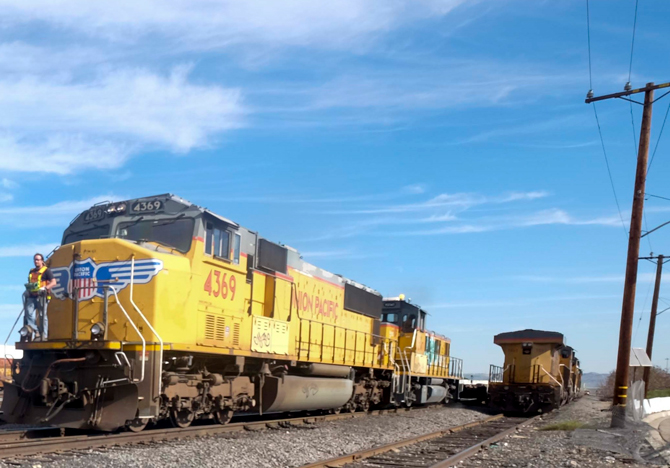
A five-year dispute over a plan by BNSF Railway Co. and the City of Los Angeles to develop a new railyard at the Port of Los Angeles could be headed to the California Supreme Court.
The proposed $500 million project has drawn a coalition of opponents that includes the City of Long Beach – which owns its port next to L.A.’s – Long Beach Unified School District, the South Coast Air Quality Management District and nonprofit environmental group Natural Resource Defense Council Inc., among others.
The possibility of a showdown in the state’s highest court comes on the heels of a partial setback dealt to the proposed railyard by the First Appellate District Court in San Francisco on Feb. 1. The appellate court denied a petition by BNSF, the city of Los Angeles and the Port of Los Angeles seeking to let the city’s prior approval of a final environmental impact report on the project stand while it does more work on two portions of the document called into question.
A nod from First Appellate court would have green lighted construction to begin on the project as the parties further studied how air quality and the project’s cumulative impact might affect the surrounding communities.
The denial essentially eliminates the chance of work on the railyard beginning anytime soon.
A petition for a hearing by the Supreme Court could come as opponents seek to head off a potential re-certification of the environmental document.
Authorized to file
Mike Mais, assistant city attorney for the city of Long Beach, confirmed to the Business Journal that his office has been authorized to file a petition with the state Supreme Court to hear the case.
“We have until Feb. 23 to file, and we fully intend to do so,” said Mais, whose office received the authorization in a vote taken during a recent closed session of the Long Beach City Council.
The Supreme Court chooses what cases to hear. The body could take up the challenge by opponents and reach a resolution by the end of the year, Mais said.
The legal battle over the long-proposed project – dubbed the Southern California International Gateway – has carried on for nearly five years, with the City of Los Angeles and the city-owned Port of Los Angeles supporting Fort Worth, Texas-based BNSF’s proposed project of a near-dock facility four miles from the port and on port property.
BNSF currently has a railyard in Commerce, 24 miles from the side-by-side ports. Freight is trucked there in intermodal containers, and transferred to trains for delivery all over the country.
BNSF says that a facility much closer to the ports would streamline its handling of freight meant for long-distance delivery. A closer yard would sharply reduce new truck emissions in the overall L.A. region, the supporters claim, cutting the 24-mile drive to Commerce down to a short hop in the immediate area of the ports.
BNSF, a unit of Warren Buffett’s Berkshire Hathaway Inc., first proposed the 153-acre railyard in 2005.
The opposition seeks to overturn the 2013 approval of the project by the City of Los Angeles. They contend that the potential negative environmental effects of the project would disproportionately hit residents of West Long Beach.
A 2016 hearing in a Contra Costa County trial court – the City of Los Angeles asked for a change of venue after the case had gotten a lot of local publicity – led to ruling in favor of opponents of the project. The court held that the final EIR had failed to provide a complete analysis of the railyard, essentially overturning the City of L.A.’s approval and halting construction.
The city and BNSF appealed the ruling in the First Appellate District Court, which led the Feb. 1 ruling and a partial win for the City of Los Angeles and BNSF, as the court struck down several of the opposition’s environmental concerns.
The court stopped short of a go-ahead, though, ruling that the EIR was inadequate in providing a complete analysis of environmental impacts. The court pointed out two issues that need further assessment: air quality and cumulative impact.
Methodology
“For air quality, there’s a dispute about the methodology BNSF and the port used, we felt it was deceptive,” said David Pettit, senior attorney with the National Resource Defense Council. “And for cumulative air pollution impact, they looked at the project in isolation instead of considering the site’s surroundings.”
Industrial facilities surround the BNSF site but in its vicinity are also single-family homes, five schools, two child care centers, a housing complex, medical center among other facilities – in Long Beach.
The proximity to homes and schools is the root of the problem, said Rachel Hooper, an attorney at San Francisco-based Shute, Mihaly & Weinberger, which represents the city of Long Beach in the case.
The Port of L.A. argues that the near-dock railyard would largely replace air-polluting diesel trucks with natural gas trucks and clean railyard equipment, among other benefits, and eliminate the 1.3 million annual truck trips to BNSF’s Commerce facility, ultimately improving air quality and traffic congestion on the 710 freeway.
However, it’s unclear if the company would add or shift operations at the Commerce site to the SCIG site, should it be built.
